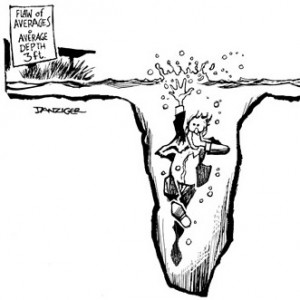In his brilliant book ‘The Flaw of Averages: Why We Underestimate Risk in the Face of Uncertainty’ Dr Sam Savage shows us why we need to connect the ‘seat of the intellect to the seat of the pants’.
Savage’s message is that we can fly intuitively by the seat of our pants for some types of decisions but that failing to engage the brain for others could mean our pants end up around our ankles. Should those projects with bigger budgets and a higher chance of failure be subject to more robust decision-making?
How do we make decisions?
I suspect that decisions and behaviours in organisations are distorted by intuition and judgement more than we’d like to admit. We all fall prey to these cognitive biases, however rational we like to think we are. Don’t worry, its human. So is our denial. However when the effects of cognitive bias aren’t understood, recognised and mitigated the stage is set for some questionable decision-making. There are great examples of how this plot unfolds in ‘Why plans fail – Cognitive Bias and Decision-Making’ by Jim Benson.
If you’re still not convinced, read ‘Thinking Fast and Slow’ by Daniel Kahneman and his earlier work with Amos Tversky. The former won a Nobel Prize for his work in behavioural economics which describes how our intuition, the ‘gut feel’, makes irrational decisions in the presence of uncertainty. Combine the ‘halo effect’ with the ‘illusion of knowledge’, throw in some ‘cognitive dissonance’ and we can also see why decision-makers are held up to be (and may even believe themselves) immune to these effects.
Big Gambles. Little Evidence.
How do we know when decisions have been based on good evidence, bad evidence or faulty judgement and how do we know if they were successful? If the organisation is investing in new technology, letting an outsourcing contract, reorganising, shedding headcount or making service improvements then its making bets on some outcome. Perhaps the outcome itself is expressed in vague jargon. Our natural over-confidence and biases make success seem inevitable in our heads when there’s actually some probability of a negative result. If no-one is asking “Where’s the evidence?” then alarm bells should be ringing.
Making decisions using selective evidence or using biased sources such as suppliers can be a problem too, whether unintentional or deliberate. Decisions can also be distorted by a culture of fear and blame where evidence is suppressed or sanitised to duck punishment for ‘bad’ decisions whilst at the same time losing the ability to experiment, learn and celebrate ‘good’ ones.
Hype & Ideology
There are also dangers lurking in the things which might be considered self-evident as Pfeffer & Sutton describe in their book ‘Hard Facts, Dangerous Half-Truths, and Total Nonsense: Profiting from Evidence-based Management’. Doing things which are believed to have worked elsewhere (but proof is scarce) or following deeply held (but untested) ideologies are just two examples. Does that remind you of a new technology hype, a ‘best practice’ framework, a new boss keen to make an impact? Unchallenged decisions can seep into the collective sub-consciousness and become inherited beliefs, however flawed. Or decisions which are unsupported by evidence can breed resentment and even sabotage by those affected by them.
Evidence-based Management might sound new-fangled but it isn’t. Not where decisions really matter; in health for example. Take Stacey Barr’s post about why we should trust scientific evidence in spite of personal bias or even the media’s pursuit of a story. Ben Goldacre has a done a lot to expose this kind of ‘Bad Science’ in the press.
Uncertainty Reduction
Making good decisions needs evidence and evidence needs measurement. This is measurement in the broadest sense:
‘A quantitatively expressed reduction of uncertainty based on one or more observations’
according to Doug Hubbard’s ‘How to Measure Anything: Finding the Value of Intangibles in Business’. Hubbard, like Savage*, is an exponent of probabilistic methods and creator of Applied Information Economics for measuring the value of information itself and reducing uncertainty in the variables most likely to have an economic impact.
Better Decisions start with Better Thinking
Organisations can seek out, learn and apply new methods which trump intuition in the face of big decisions. Whether you call it Operational Research, Management or Decision Science, better decisions always start with deliberate, deeper analytical thinking.
As shareholders, tax payers and employers, shouldn’t we expect leaders to make decisions using robust methods and then prove that they’ve created, not destroyed, value? I’d like to think so.
*Savage’s dad Leonard Jimmie Savage was a giant of Bayesian decision theory in the 1950s so you might expect him to know a thing or two about probability.
